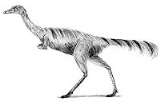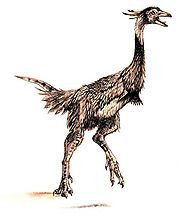
Mononykus
Encyclopedia
Mononykus was a theropod dinosaur
from late Cretaceous
Mongolia
(Nemegt Formation
, about 70 million years ago) with long, skinny legs. It moved about on two legs, was very nimble, and could run at high speeds, something that would have been useful in the open desert
plain
s where it lived. It had a small skull, and its teeth were small and pointed, suggesting that it ate insects and small animals, such as lizards and mammals. Large eyes allowed Mononykus to hunt by night, when it was cooler and there would have been fewer predators about. Mononykus was originally named Mononychus in 1993, but later that year, it was renamed because the original name had already been used for a beetle
named by Johann Schueppel, a German entomologist.
bones similar to those of birds, and a keeled breastbone. It differed from close relatives Shuvuuia
and Parvicursor
in several details of its skeleton, including a pubic bone that is triangular in cross section, and different proportions in the toe bones.
Mononykus is currently represented by a single holotype
specimen, catalog number IGM N107/6. This specimen consists of a partial skeleton lacking a tail, and only small fragments of skull bones, including a complete braincase. Several other specimens were later misclassified as Mononykus, including specimens with partial tails (initially misinterpreted as being very short, though later specimens showed they were long and thin) and complete skulls showing a distinct, mostly toothless form. However, these specimens have since been reclassified in the new genus Shuvuuia
. Because of this, many reconstructions of Mononykus in art and mounted skeletons in museums are in fact based mainly on Shuvuuia.
While Mononykus was formally described in the 1990s, it was reported that a specimen possibly belonging this genus had already been unearthed by the Andrews
expedition decades before. The specimen had been in the American Museum of Natural History
collection, labeled simply as "bird-like dinosaur". However, given the re-assignment of the other specimens to related genera, and the difference in age (the AMNH specimen is from the older Djadochta Formation
), it is unlikely to be Mononykus.
 Mononykus was a member of the family Alvarezsauridae
Mononykus was a member of the family Alvarezsauridae
and, like its relatives, had very strange, stubby forearms with one large, approximately long claw (hence its name). The other two claws had disappeared (however, a close relative of Mononykus, Shuvuuia
, had two vestigial claws, alongside one large claw). The purpose of these highly specialized arms is still a mystery, but some scientists have suggested they were used to break open termite
mounds (like modern anteaters), and therefore it is possible that they fed primarily on insects.
Mononykus is usually reconstructed with a covering of feathers. Indeed, in the fossil of its relative Shuvuuia feather traces were discovered, proving that Alvarezsauridae were among the theropod lineages with feathery or downy integument.
In a 2001 study conducted by Bruce Rothschild and other paleontologists, 15 foot bones referred to Mononykus were examined for signs of stress fracture
, but none were found.
special "The Giant Claw", where one specimen is captured by Nigel Marven
during his journey in Cretaceous Mongolia to find a Therizinosaurus.
Dinosaur
Dinosaurs are a diverse group of animals of the clade and superorder Dinosauria. They were the dominant terrestrial vertebrates for over 160 million years, from the late Triassic period until the end of the Cretaceous , when the Cretaceous–Paleogene extinction event led to the extinction of...
from late Cretaceous
Cretaceous
The Cretaceous , derived from the Latin "creta" , usually abbreviated K for its German translation Kreide , is a geologic period and system from circa to million years ago. In the geologic timescale, the Cretaceous follows the Jurassic period and is followed by the Paleogene period of the...
Mongolia
Mongolia
Mongolia is a landlocked country in East and Central Asia. It is bordered by Russia to the north and China to the south, east and west. Although Mongolia does not share a border with Kazakhstan, its western-most point is only from Kazakhstan's eastern tip. Ulan Bator, the capital and largest...
(Nemegt Formation
Nemegt Formation
The Nemegt Formation is a geological formation dating from the Late Cretaceous sedimentary from the Gobi Desert of Mongolia. It overlies and sometimes forms folds with the Barun Goyot Formation. It consists of river channel sediments and contains fossils of fish, turtles, crocodilians, birds and a...
, about 70 million years ago) with long, skinny legs. It moved about on two legs, was very nimble, and could run at high speeds, something that would have been useful in the open desert
Desert
A desert is a landscape or region that receives an extremely low amount of precipitation, less than enough to support growth of most plants. Most deserts have an average annual precipitation of less than...
plain
Plain
In geography, a plain is land with relatively low relief, that is flat or gently rolling. Prairies and steppes are types of plains, and the archetype for a plain is often thought of as a grassland, but plains in their natural state may also be covered in shrublands, woodland and forest, or...
s where it lived. It had a small skull, and its teeth were small and pointed, suggesting that it ate insects and small animals, such as lizards and mammals. Large eyes allowed Mononykus to hunt by night, when it was cooler and there would have been fewer predators about. Mononykus was originally named Mononychus in 1993, but later that year, it was renamed because the original name had already been used for a beetle
Beetle
Coleoptera is an order of insects commonly called beetles. The word "coleoptera" is from the Greek , koleos, "sheath"; and , pteron, "wing", thus "sheathed wing". Coleoptera contains more species than any other order, constituting almost 25% of all known life-forms...
named by Johann Schueppel, a German entomologist.
Description
Mononykus was a small dinosaur, only 1 metres (3.3 ft) long. Other characteristics include fused wristWrist
In human anatomy, the wrist is variously defined as 1) the carpus or carpal bones, the complex of eight bones forming the proximal skeletal segment of the hand;...
bones similar to those of birds, and a keeled breastbone. It differed from close relatives Shuvuuia
Shuvuuia
Shuvuuia is a genus of bird-like theropod dinosaur from the late Cretaceous period of Mongolia. It is a member of the family Alvarezsauridae, small coelurosaurian dinosaurs which are characterized by short but powerful forelimbs specialized for digging. The type species is Shuvuuia deserti, or...
and Parvicursor
Parvicursor
Parvicursor is a genus of tiny maniraptoran dinosaur with long slender legs for fast running. At only about 39 cm from snout to end of tail, and 162 grams in weight, it is one of the smallest non-avian dinosaurs known from an adult specimen.Like other members of the family Alvarezsauridae,...
in several details of its skeleton, including a pubic bone that is triangular in cross section, and different proportions in the toe bones.
Mononykus is currently represented by a single holotype
Holotype
A holotype is a single physical example of an organism, known to have been used when the species was formally described. It is either the single such physical example or one of several such, but explicitly designated as the holotype...
specimen, catalog number IGM N107/6. This specimen consists of a partial skeleton lacking a tail, and only small fragments of skull bones, including a complete braincase. Several other specimens were later misclassified as Mononykus, including specimens with partial tails (initially misinterpreted as being very short, though later specimens showed they were long and thin) and complete skulls showing a distinct, mostly toothless form. However, these specimens have since been reclassified in the new genus Shuvuuia
Shuvuuia
Shuvuuia is a genus of bird-like theropod dinosaur from the late Cretaceous period of Mongolia. It is a member of the family Alvarezsauridae, small coelurosaurian dinosaurs which are characterized by short but powerful forelimbs specialized for digging. The type species is Shuvuuia deserti, or...
. Because of this, many reconstructions of Mononykus in art and mounted skeletons in museums are in fact based mainly on Shuvuuia.
While Mononykus was formally described in the 1990s, it was reported that a specimen possibly belonging this genus had already been unearthed by the Andrews
Roy Chapman Andrews
Roy Chapman Andrews was an American explorer, adventurer and naturalist who became the director of the American Museum of Natural History. He is primarily known for leading a series of expeditions through the fragmented China of the early 20th century into the Gobi Desert and Mongolia...
expedition decades before. The specimen had been in the American Museum of Natural History
American Museum of Natural History
The American Museum of Natural History , located on the Upper West Side of Manhattan in New York City, United States, is one of the largest and most celebrated museums in the world...
collection, labeled simply as "bird-like dinosaur". However, given the re-assignment of the other specimens to related genera, and the difference in age (the AMNH specimen is from the older Djadochta Formation
Djadochta Formation
The Djadochta Formation is situated in central Asia and dates from the Late Cretaceous Period. Laid down in the early Campanian, possibly starting in the latest Santonian, it is dated somewhat uncertainly at about 84-75 mya...
), it is unlikely to be Mononykus.
Paleobiology

Alvarezsauridae
Alvarezsauridae is an enigmatic family of small, long-legged running dinosaurs. Although originally thought to represent the earliest known flightless birds, a consensus of recent work suggests that they are primitive members of the Maniraptora. Other work found them to be the sister group to the...
and, like its relatives, had very strange, stubby forearms with one large, approximately long claw (hence its name). The other two claws had disappeared (however, a close relative of Mononykus, Shuvuuia
Shuvuuia
Shuvuuia is a genus of bird-like theropod dinosaur from the late Cretaceous period of Mongolia. It is a member of the family Alvarezsauridae, small coelurosaurian dinosaurs which are characterized by short but powerful forelimbs specialized for digging. The type species is Shuvuuia deserti, or...
, had two vestigial claws, alongside one large claw). The purpose of these highly specialized arms is still a mystery, but some scientists have suggested they were used to break open termite
Termite
Termites are a group of eusocial insects that, until recently, were classified at the taxonomic rank of order Isoptera , but are now accepted as the epifamily Termitoidae, of the cockroach order Blattodea...
mounds (like modern anteaters), and therefore it is possible that they fed primarily on insects.
Mononykus is usually reconstructed with a covering of feathers. Indeed, in the fossil of its relative Shuvuuia feather traces were discovered, proving that Alvarezsauridae were among the theropod lineages with feathery or downy integument.
In a 2001 study conducted by Bruce Rothschild and other paleontologists, 15 foot bones referred to Mononykus were examined for signs of stress fracture
Stress fracture
A stress fracture is one type of incomplete fracture in bones. It is caused by "unusual or repeated stress" and also heavy continuous weight on the ankle or leg...
, but none were found.
In popular culture
Mononykus appears in the BBC series Chased by DinosaursChased by Dinosaurs
Chased by Dinosaurs is a BBC program featuring Nigel Marven as a time-traveller who encounters dinosaurs in the wild. The two-part series, a sequel to Walking with Dinosaurs, was broadcast over Christmas 2002 and featured Nigel and his "team of fellow explorers" encountering prehistoric life over a...
special "The Giant Claw", where one specimen is captured by Nigel Marven
Nigel Marven
Nigel Marven is a British wildlife presenter, television producer, author, and ornithologist.-Career:Marven studied botany at Bristol University until the age of 22 when he left to begin his career at the BBC Natural History Unit in Bristol...
during his journey in Cretaceous Mongolia to find a Therizinosaurus.

